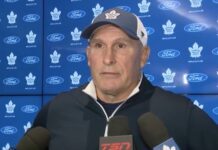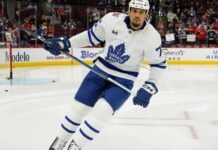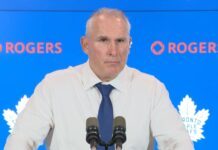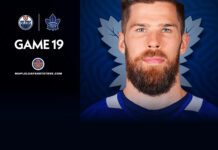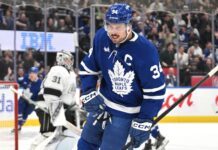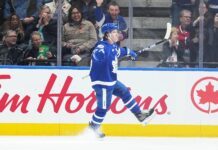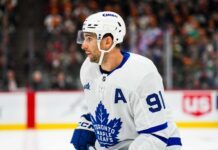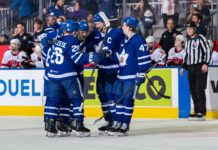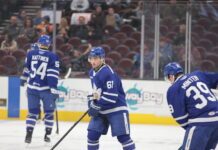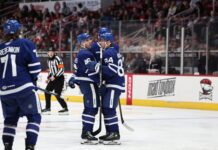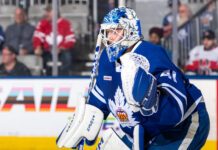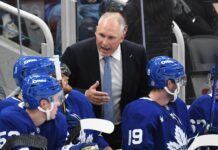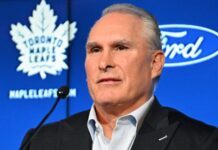MLHS’ Alec Brownscombe caught up with Leafs Director of Player Development Jim Hughes this morning to talk about some of the younger Maple Leafs. While much of the Leafs scouting staff heads to Bratislava next week for the Ivan Hlinka U18 tournament, Hughes will be taking in the World Junior exhibition games in Lake Placid. Dominic Toninato will participating for Team USA while Ryan Rupert, Matt Finn, Morgan Rielly and Frederik Gauthier will be playing for Canada.
Alec Brownscombe: What does the job of Director of Player of Development involve on a day to day basis?
Jim Hughes: My job is to monitor our draft picks, our drafted players. We have about 16 amateur scouts who work hard at identifying particular kids, and once they’re drafted we pass them over to the player development department, which includes myself, Bobby Carpenter and Steve Staois. At that point, we monitor their progress, we share the good news with them, we talk with the things they need to work on and improve, we develop relationships with their coaches, we make sure they are in good spots, and we make recommendations that they should maybe stay in school for another year. We may make recommendations on who we should sign and possibly who we should pass on. We’re constantly nurturing and talking to the kids about situations, about professionalism, about pro hockey, about habits, work ethic, skill sets. Every kid is different. Some are physically strong early, some aren’t. We show them video clips, and we most importantly support what their coaches are talking to them about. We support what their coaches are saying and then we may tack on a little bit more than that. We want to make sure our message is always consistent. Myself and Bobby always make sure we’re on the same page so that our message is consistent. We need to be consistent with the coaching staffs and the general managers, wherever these kids may be playing.
AB: What type of life coaching does the Maple Leafs organization do for its prospects? I know the team emphasizes off ice humanitarianism and intangibles like clean living.
JH: We just recently had prospect camp, so we talked to them about media awarenesses, about Twitter’ing. We talked to them about cooking, we had cooking classes with chefs. We basically talk to them about taking initiative in their lives and business, and making what they want out of this hockey lifestyle. If you’re good, become great; if you’re average, then you have to work hard. You got to be your best, you’ve got to put that effort in, and you’ve got to concentrate on the details. Again, it’s taking the initiative, the responsibility. What we’re trying to do is be patient with the kids, and yet we’re trying to expedite the process and give them the information so that no kid when he’s 24 or 25 can say, “nobody ever told me that,” because they have been told. We’re advocates of kids that go to bed early and wake up early. Kids that eat a healthy, hearty breakfast, guys that are eating the right food groups, guys that get their training in in the morning, guys that take initiative in knocking on the coach’s door looking to either get video attention or maybe additional individual instruction on the ice from their coaching staff. There’s a multitude of things. We have a lot of resources between Barbara Underhill doing our power skating, Dana Sinclair is our sports psychologist [more on Dana here], and we constantly are urging our players to use these resources. Anthony Belza does a great job with the strength and conditioning side of things. We are constantly trying to stimulate their minds so that their minds function in such a way where we’re making NHL players.
AB: Nazem Kadri is training with Leafs trainers Barbara Underhill and Anthony Belza instead of Gary Roberts, who he worked with last off season. Why did the team decide to keep him in house, and did it have anything to do with Dallas Eakins being a little disappointed in his conditioning last training camp?
JH: It’s a probably a multitude of all of those things. He came in house because he understands the value Belza brings, and he’s probably matured to the point where he understands that Barbara can help him. It’s part of that maturation period, and he’s really wrapped his head around it. He’s done a wonderful job this year on a consistent basis. He’s the first guy in in the morning, he’s got his eye on the ball, and he’s putting time in and working hard, certainly from a physical standpoint. I’d imagine he’s working on the mental side of it as well. He’s made a lot of forward strides in the last 18 months, and I assume that he’ll continue to move in that direction.
AB: Is this the year Colborne finally breaks the NHL full time? What are you hoping to see from Joe this season, and do you think he could benefit from full-time NHL duty even if it’s on the 4th line?
JH: It’s a loaded question and I guess the answer to the question will be that it’s up to Joe and his desire and his determination to do whatever Randy and his coaching staff ask of him. I’m sure they’ll give him instruction that you’re going have to do x, y and z in order to play in the lineup or you simply won’t be in the lineup. It may not be about scoring, it may be about checking, physicality, and being stronger on loose pucks. I don’t know what items they’ll discuss, but at the end of the day it is always the player who will have the opportunity to make what the player wants. He’s got a foot in the door, and it’s really a matter of whether he take advantage of the opportunity. Does he seize it? Not wait for it to be given to him, but to simply go out and take a spot and make it his business to take a spot. He’ll have to demonstrate that and show Randy that he belongs. Through the exhibition series we’ll have an answer to those questions.
AB: Moving on to some still-amateurs, we’ll start with who is bound to get the most attention at training camp among the youngsters. Do you think Morgan Rielly has anything left to gain in the WHL should he return for another year?
JH: I don’t know yet. It’s still undecided. I think judgment day will be the rookie camp, leading into training camp, leading into NHL exhibition games, leading into the beginning of the NHL regular season. At that point, there will be discussions of where he belongs. Will he be getting NHL duty, coached by NHL coaches, being nurtured by Randy and his staff, and playing a fair number of games, or is it sending him back and allowing him to dominate at the WHL level. One thing is for certain, I assume he’ll be on that World Junior team which will be a great experience. Regardless of what happens with Morgan, it’s not going to be because there’s something missing in his game. He’s very goal oriented, he’s sharp as a tack in his mind, he’s hungry to get to the NHL, and he’s a strong kid with a wide base and a wide foundation; he doesn’t get knocked off the puck easily. He’s got good hockey sense and played very well for the Marlies. It’s really about sort of being patient with him and making sure we activate him at the right time.
AB: Petter Granberg is also getting some hype after his performance at the World Championships. Do you think based on how he fared against the older competition, and how he looked in the prospect camp, he could really challenge for a spot or is he likely to need an adjustment period to the North American style of play and rink size down with the Marlies?
JH: I assume it would be option number two. Let’s see how he comes in and performs early, and how he looks in the month of September. It will give Dave and Randy a better sense of where he’s at. I don’t believe, if Petter played 25 or 30 or 40 AHL games, that it would hurt him. It would be part of the process to get acclimated to North America, and to get real comfortable with his game and sort of take it from there. He certainly demonstrated in the World Championships that he’s a high-end player who can shut down guys, who defends very well off the rush, and he plays in 4 on 4, 5 on 5 and PK situations. He’s certainly a good prospect, but again I think the AHL, like most players, it would not hurt him to go down and play a boatload of games. It would give him a better North American foundation.
AB: Jesse Blacker has now had two full seasons with the Marlies. What does he need to do to take the next step?
JH: He needs to probably be an AHL All Star this year. He’s got great physical ability. He’s strong and he can skate and he loves the game. Now he just needs to tighten up his game and be a solid defender. I think we’ll see that as he matures. He’s got two years under his belt, he needs to stay healthy and strong, and he needs to be consistent from start to finish. Be a guy who can demonstrate a shutdown role and a good first pass, a guy who can defend who from shift to shift, and show his great hockey sense. I think that, over time, Jesse has realized he doesn’t need to chase the game but let the game come to him. He’s got that great passion, he loves the game, and he basically will do whatever it takes to be an NHL player. Let’s see how it unfolds.
AB: Same goes for Jerry D’Amigo – two and a half seasons, actually. Why do you think he’s been especially effective for the Marlies in the playoffs, first off? He’s been a point a game performer. Could he be ready to challenge for a bottom six wing role in the not so distant future?
JH: I don’t have the answer to that. He’ll get a real good look and a opportunity to see where he’s at and see if he can make the next step. He certainly can kill penalties, he can certainly skate, he’s certainly aggressive. Now, can he take his game to the next level? I guess that will be decided again in September to see where his game is at. Coming out of the World Juniors and when he went into Kitchener, we know he’s got ability. Maybe he needs a chance now, a good, hard, solid long look to see if he can take his game to the next level. We’ll where it goes with that.
AB: Speaking of Kitchener, I came away very impressed with Josh Leivo in a few viewings this season. How much does a good +1 or +2 year for a prospect change original expectations for a lower round draft pick like Leivo? I guess Connor Brown would be in the same boat.
JH: Well, quite honestly we don’t really care what pick Josh is or Connor. They both can play the game, they both love the game. Josh has come a long way. It’s a guy who we drafted when he was 178 pounds and now he’s 200. He’s wired correctly, he’s got NHL thoughts, he’s very quick, he’s got an NHL stick, he’s got nice soft hands, and he’s got his eye on the ball. He’s worked hard this summer. He’s certainly a top six guy, a guy who can generate offense. When he has the puck, it’s really hard to take it away from him. He protects it well. Again, he’s somebody who we think can put up some numbers. He needs to really come out of the shoot fast. He’s comfortable with Steve Spott and hopefully he can come out of the shoot fast and have a great AHL start and we’ll see where it goes. He’s on the right track and he’s a very good prospect.
Connor will go back to Erie. He’s another guy who is skilled. He’s got some slippery speed and some soft hands. He loves the game. He has the ability to make offensive plays. I’m sure he’ll play with McDavid again this year. His situation is that we just got to be patient with him and let him continue to get stronger and continue to grow. He’s really young. If we can put 5 pounds on him this year, 5 pounds on him next year; once this guy becomes a man, he’s going to be very effective. We just need to allow him to go play junior hockey and have another great season and see where his progression is and figure out what the next step would be for him. Would it be an AHL season after that, or would it be an overage year with McDavid? We’ll see how that plays out. As you mentioned, both Leivo and Brown have some upside offensively and they’re both working really hard again this summer.
It’s all about time and patience. Some of these guys we project are 12 months out, some are 24 months out, some are 36 months out and some are 48 months out. A guy like Carter Verhaeghe might be 48 months out. We’ve got short term projections and then we’ve got long term projections.
AB: What are you hoping to see from Tyler Biggs this season? Will it be with the Marlies?
JH: If it is with the Marlies, he basically needs to come in here and just needs to take the spot. Take the spot. Don’t wait for it to be given to you. Take it, be aggressive about it, take ownership in the group immediately and be the guy. He’s got those capabilities. Steve Spott is very familiar with him as a player. He’s going to be given the opportunity and he’s going to be empowered. He needs to embrace that, and take that opportunity and really run with it. Really run with it. It would be in all situations. He should be on the powerplay, he should be a PK guy, a 5 on 5 and a 4 on 4, and he should get ample minutes. He’s got so much physical ability that he shouldn’t allow anybody to get in his way. We believe he has the capability of doing that.
AB: In terms of other big, physical guys with the Marlies, could David Broll find his way into the NHL as an enforcer before long, or is the plan to give him ample time with the Marlies and try to unearth or develop a bit of an offensive game?
JH: Probably a little bit of both. He can continue to work on his offensive point production. In a lot of ways, it will be up to David Broll in how he fast he wants to make this happen. He can go out of his way and make it his business to grab people’s attention and do it early and do it often. The more he does it, and the sooner he does it, the sooner he will be recognized and acknowledged. It’s simply going to be up to David Broll. Steve Spott loves the way he plays. He will be given every opportunity. It will be up to him to really, similar to Biggs, to take the opportunity and make it what he wants for himself. He can skate, he can protect the puck, he’s got really good hockey sense, he’s got soft hands, then he’s got the physical part where he can hit and he can fight. He needs to take all of those tools and use them and apply them. It will be fun to watch some of these guys and see where they take their games.
AB: Yeah, the prospect of a prospect-heavy, quite young Marlies team must be exciting. There could be a dozen players on entry level contracts playing on the Marlies, which is mostly the work of this current development and scouting staff. That has to be exciting for you.
JH: I think it will be a lot of fun to watch these guys perform on a nightly basis. They’ll take their lumps; they’ll win some games and lose some games, but some of these guys, not all of them, will be a big part of our future. They’ll play with Maple Leaf jerseys on some day. This is again part of the process in the American league. It’s a wonderful league for these guys to work on their trade, grow as young professionals, to really embrace as a team and maybe win a trophy, and yet on an individual level basis to make themselves better every single day. They have the opportunity to make themselves better everyday. Some take advantage of the opportunity and others may not, but they certainly have been told as we discussed at the beginning of this conversation.
There’s one guy you are missing who is a little bit of a blue chip. Andrew MacWilliam. He played at North Dakota, he played four years and was the Captain at North Dakota last year. This is a big, imposing physical player. He’s a good first pass guy. He is mean and it’s natural. He’s very competitive. He’s got the right mentality, he’s got a pro mentality. He’s got some force when he hits. His puck skills have really improved over the last four years; he can move the puck efficiently. He’s got the mental makeup that is going to take him a long way in this sport. He’ll be fun to watch and we’ll see what he does at the AHL level, but this is a big, physical player. He might be a lot like Mark Fraser down the road; a big, physical, left-shot D, a #5 guy who brings a physical presence to the team. He’ll be another one of those guys who comes in, plays solid minutes, gets some AHL experience, but he certainly has the mentality and the makeup.
AB: Overall, where is the Leafs prospect system deepest and where is it shallowest?
JH: Dave Morrison and his crew supplied us with an awful lot of ingredients right now. We’ve got Gauthier at the center spot now, we’ve got some skill with Leivo and Brown, and we’ve got some girth with Biggs and Broll. We’ve got Verhaeghe who’s got skill. We’ve got Stuart Percy who has tremendous hockey sense. We’ve got some physicality in MacWilliam and some shutdown with Granberg and Blacker. We’ve got a lot of ingredients right now; we’ve got size, we’ve got skill. Let’s just see how this all unfolds. Some will develop faster than others, some we’ll need to be patient with, but I think we feel pretty good in all areas of where we’re at right now from a development standpoint.
AB: Frederik Gauthier has been projected as a third line center by Dave Nonis after the draft and Dave Morrison when we talked to him earlier in the week. Do you agree with that projection? His numbers, for a first-year rookie who battled a broken jaw, were actually pretty good.
JH: I do agree with it. Let’s see where his offensive skill sets take him, but when you’re talking about an NHL playoff team, Gauthier is probably in the three spot. If you’re talking about a non-playoff team, Gauthier is in the two spot. To be realistic, if you’ve got Gauthier in the three spot, you most probably have a pretty good hockey team. With that big physical size that can get up and down the rink, he plays 200 feet and he’s got a good skill set. If you put him in a two spot, he’s biting off more than he can chew. If you keep him in the three spot, it’s probably a good spot for him. We’ll let him go do his thing and in three years or three and a half years from now I think we’ll have something special there.


